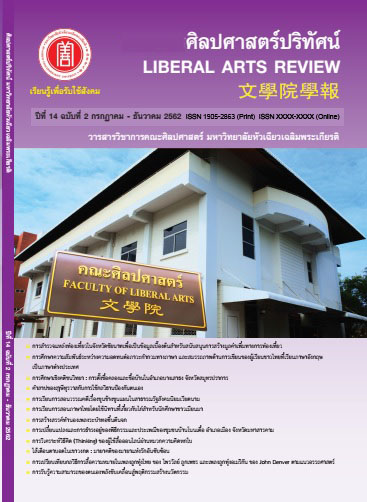Self-efficacy Mobilizes toward Innovative Behavior
Keywords:
Self-efficacy, Innovative BehaviorAbstract
Self-efficacy is a cognitive process that occurs from the reciprocal manner by the dynamic interplay of 3 factors: personal, environmental, and behavioral section. That process influences the believes of one’s capability. Self-efficacy is specific matter according to the content, context or circumstance in which a person is currently facing. The innovative behavior consists of initiatives, ideation of new products or distinct concepts, dissemination, and implementation of those new ideas. The innovative behavior is another context in which innovators have different perceptions of their capabilities. The plenty of studies have illustrated that self-efficacy enhances, develops and maintains the desirable behaviors, excellent work performance, and better quality of life. In this article, the focuses are on how self-efficacy can empower a person in terms of innovative behaviors, the additional factors which encourage innovative behaviors, and the factors that enhance the level of self-efficacy. The article is beneficial to design activities, plan management system, establish a strong teamwork, and create the supportive environment for innovative behaviors.
References
กนกนาฏ เอียดมาก กนกวรรณ สุขโณ จุฑาทิพย์ แดงเหมือน สาวิตรี วงค์งาม วรรณภรณ์ บริพันธ์ และสัญชัย
ลั้งแท้กุล. (2561). พฤติกรรมการสร้างนวัตกรรมของบุคลากรในมหาวิทยาลัย จังหวัดสงขลา. รายงานการ
ประชุมสืบเนื่องการประชุมวิชาการระดับชาติ วลัยลักษณ์วิจัย ครั้งที่ 10 วันที่ 27-28 มีนาคม 2561. เข้าถึงจาก http://www.wjst.wu.ac.th/index.php/wuresearch.
ตรีทิพ บุญแย้ม. (2554). ปัจจัยเชิงสาเหตุพหุระดับที่มีอิทธิพลต่อพฤติกรรมสร้างนวัตกรรมระดับบุคคลและระดับ
กลุ่มงานเพื่อสร้างนวัตกรรมผลิตภัณฑ์ในบริษัทเอกชนของไทย. ปริญญาวิทยาศาสตรดุษฎีบัณฑิต
การวิจัยพฤติกรรมศาสตร์ประยุกต์ มหาวิทยาลัยศรีนครินทรวิโรฒ.
ธนกฤต แซ่โค้ว. (2558). ปัจจัยด้านองค์กรที่ส่งผลต่อพฤติกรรมเชิงนวัตกรรมในการปฏิบัติงานเพื่อรองรับ
เศรษฐกิจอาเซียนของกลุ่มอุตสาหกรรมแปรรูปเนื้อสัตว์ในเขตกรุงเทพมหานครและปริมณฑล
การค้นคว้าอิสระ บริหารธุรกิจมหาบัณฑิต บัณฑิตวิทยาลัย มหาวิทยาลัยกรุงเทพ.
นาฎวดี จำปาดี. (2554). การรับรู้ความสามารถของตนเอง รูปแบบความคิดสร้างสรรค์ และปัจจัยส่วนบุคคลที่มี
ผลต่อพฤติกรรมการสร้างสรรค์นวัตกรรม : กรณีศึกษาบริษัทให้คำปรึกษาและพัฒนาระบบคอมพิวเตอร์
แห่งหนึ่ง. ปริญญาศิลปศาสตรมหาบัณฑิต สาขาจิตวิทยาอุตสาหกรรมและองค์กร คณะศิลปศาสตร์ มหาวิทยาลัยธรรมศาสตร์.
วสันต์ สุทธาวาศ ประสพชัย พสุนนท์. (2558). ปัจจัยที่ส่งผลต่อพฤติกรรมสร้างนวัตกรรมระดับบุคคลใน
สำนักงานคณะกรรมการการศึกษาขั้นพื้นฐาน. Veridian-E-Journal, Silpakorn University (ฉบับ
ภาษาไทย) สาขามนุษยศาสตร์ สังคมศาสตร์ และศิลปะ 8 (1), 530-545.
Bandura, A. (1986). Social Foundations of Thought and Action: A Social Cognitive Theory.
Englewood Cliffs, New Jersey: Prentice –Hall.
_______ . (1997). Self-efficacy the Exercise of Control. New York: W.H. Freeman and Company.
Bartel, C., Wrzesniewski, A., & Wiesenfeld, B. M. (2012). Knowing where you stand: physical
isolation, perceived respect, and organizational identification among virtual employees.
Organization Science, 23, 743-757. http:// dx.doi.org/10.1287/orsc.1110.0661.
Bray-Clark, N., & Bates, R. (2003). Self-efficacy Belief and Teacher Effectiveness: Implications for
Professional Development. The Professional Educator, 26 (1), 13-22.
Colquitt, J. A., Scott, B. A., & LePine, J. A. (2007). Trust, trustworthiness and trust Propensity: A
meta-analytic test of their unique relationships with risk taking and job performance.
Journal of Applied Psychology, 92, 909-927. http:// dx.doi.org/10.1037/0021-9010.92.4.909.
Crossan, M. M. & Apaydin, M. (2010). A Multi-dimensional framework of organization innovation:
A Systematic review of the literature. Journal of Management Studies, 47(6), 1154-1191.
Farr, J. L. & Ford, C. M. (1990). Individual Innovation. In M.A. West & J. L. Farr (Eds). Innovation
and Creativity at work: Psychological and Organizational strategies, Chichester, UK:
John Wiley & Sons, 63-80.
Gerber, E., Martin, C. K., Kramer, E., Braunstein, J. & Carberry, A. R. (2012). Developing an
Innovation Self-efficacy Survey. Frontiers in Education Conference Proceedings 3-6 Oct,
, Seattle, Wa, USA. http:// dx.doi :10.1109 /FIE.2012.6462435.
Hargadon, A. A., & Sutton, R. I. (1997). Technology Brokering and Innovation in a Product
Development Firm. Administrative Science Quarterly, 42, 716-744.
Hsiao, Hsi-Chi., Chang, Jen-Chia., Tu, Ya-Ling., & Chen, Su-Chang. (2011) The Impact of Self-
efficacy on Innovative Work Behavior For Teacher. International Journal of Social
Science and Humanity, 1(1), 30-36. http:// dx.doi:10.7763/IjSSH.2011.v1.6.
Hsu, M. L. A., Hou, S. T., & Fan, H. L. (2011). Creative self-efficacy and innovative behavior in a
service setting: Optimism as a moderator. Journal of Creative Behavior, 45, 258-272.
https:// doi.org/10.1002/j.2162-6057.2011.tb01430.x.
Hu, B., & Zhao, Y. (2016). Creative Self-efficacy Mediates the Relationship between Knowledge
Sharing and Employee Innovation. Social Behavior and Personality: An International Journal, 44(5), 815-826. https://doi.org/10.2224/sbp.2016.44.5.815.
Huang, X., Lun, J., Liu, A., & Gong, Y. (2010). Does participative leadership enhance work
performance by inducing empowerment or trust? The differential effects on managerial
and non-managerial subordinates. Journal of Organizational Behavior, 31, 122-143.
Landrum, G. N. (2008). The Innovative Mind. New York: Morgan James Publishing.
Mojavezi, A., & Tamiz, M. (2012). The Impact of teacher self-efficacy on the students’motivation
and achievement. Theory and Practice in Language Studies, 2, 483-491.
Newman. A., Herman, H. M. Tse., Schwarz, G., & Nielsen, I. (2018). The Effects of employees’
creative self-efficacy on innovative behavior: The role of entrepreneurial leadership
Journal of Business Research. 89, 1-9. https: //doi.org/10.1016/j.jbusres.2018.04.001.
Omri, W. (2015). Innovative behavior and venture performance of SMEs: The moderating effect
of environmental dynamism. European Journal of Innovation Management, 18(2), 195-217.
Schunk, D. H. (1987). Domain-specific Measurement of Students’ Self-regulated Learning
Processes. Paper presented at the Annual Meeting of the American Educational
Research Association, Washington, DC, April 20-24, 1987.
Scott, S. G., & Bruce, R. A. (1994). Determinants of Innovative Behavior: A path model of
individual innovation in the workplace. Academy of Management Journal, 37, 580-607.
Sledzik, K. (2013). Schumpeter’s view on innovation and entrepreneurship (in:) Management
Trends in Theory and Practice, (ed.) Stefan Hittmar Available from https://
businessjargons.com/ schumpeters-theory-of- innovation. html.
Thomas, W. H. Ng., Lucianetti, L. (2016). Within –Individual Increases in Innovative Behavior and
Creative, Persuasion, and Change Self-efficacy Over Time : A Social-Cognitive Theory
Perspective. Journal of Applied Psychology, 101(1), 14-34.
Thomke, S. H. (1998). Managing Experimentation in the Design of New Product. Management
Science, 44(6), 743-762.
Yuan, F., & Woodman, R. W. (2010). Innovation behavior in the workplace: The role of
performance and image outcome expectations. Academy of Management Journal
(2), 323-342.
Widyani, A. A. D., Sarmawa, I. W. G., & Dewi, I. G. A. M. (2017). The Roles of Knowledge Sharing
in Mediating the Effect of Self-efficacy and Self-leadership Towards Innovative Behavior.
Journal Manajemen Dan Kewirausahaan, 9(2), 112-117. http:// dx.doi:10.9744/jmk.192.112-117.
Zimmerman, B. J. (2000). Self-efficacy: An Essential Motive to Learn. Contemporary Educational
Psychology, 25, 82-91.
Downloads
Published
How to Cite
Issue
Section
License
บทความที่ได้รับการตีพิมพ์เป็นลิขสิทธิ์ของวารสารศิลปศาสตร์วิชาการและวิจัย
ข้อความที่ปรากฏในบทความแต่ละเรื่องในวารสารวิชาการเล่มนี้เป็นความคิดเห็นส่วนตัวของผู้เขียนแต่ละท่านไม่เกี่ยวข้องกับมหาวิทยาลัยหัวเฉียวเฉลิมพระเกียรติ และคณาจารย์ท่านอื่นๆ ในมหาวิทยาลัยฯ แต่อย่างใด ความรับผิดชอบองค์ประกอบทั้งหมดของบทความแต่ละเรื่องเป็นของผู้เขียนแต่ละท่าน หากมีความผิดพลาดใดๆ ผู้เขียนแต่ละท่านจะรับผิดชอบบทความของตนเองแต่ผู้เดียว




